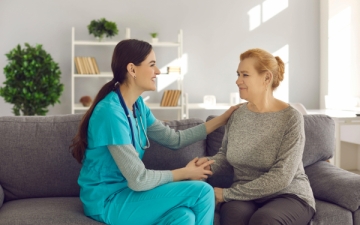
Sleep apnoea – it’s not just snoring!
This was a common misconception among NHS colleagues when I became a Respiratory Nurse Specialist in 1997. At this time, we used overnight pulse oximetry to screen for obstructive sleep apnoea (OSA) and people who were showing signs and symptoms with positive oximetry were commenced on continuous positive airway pressure (CPAP) therapy.
Since then, I have seen many innovations in this specialty and was very proud to lead the local Sleep Medicine Service as a Respiratory Nurse Consultant in the NHS Dumfries and Galloway, Scotland.
In this article, I want to focus on obstructive sleep apnoea and how this serious medical condition can give rise to significant morbidity and mortality — as well as the importance of timely diagnosis and treatment options for this disorder.
This specialist area of respiratory medicine is an ever-evolving field and new evidence is frequently being published that adds to our knowledge about how best to manage this complex condition. I learned a huge amount through studying and clinical practice of this important condition. The highlight of my career was obtaining my PhD from the University of Edinburgh in 2021 titled ‘Reviewing people with Obstructive Sleep Apnoea Hypopnoea Syndrome: Telehealth and Templates.’[1]
The types of sleep apnoea
Obstructive sleep apnoea hypopnea syndrome (OSAHS), also referred to as obstructive sleep apnoea (OSA), is the most common form of sleep apnoea and involves recurring episodes of complete or partial airway obstruction to reduced respiratory effort.[2],[3] Consequently, intermittent hypoxemia occurs, disrupting sleep,[4] which leads to excessive daytime sleepiness,[5] and reduced overall quality of life for those affected.[6]
OSAHS is believed to affect a staggering one billion individuals globally with the rate of OSA exceeding 50% in some countries.[7]
Central sleep apnoea (CSA) is a less common type of sleep apnoea.[8] It is characterised by repeated episodes of disrupted breathing during sleep due to a temporary lapse in the brain’s ability to signal the muscles responsible for respiration.[9]
CSA is thought to affect 5-10% of people with sleep disordered breathing.[10] It is often associated with underlying medical conditions, such as heart failure, stroke, or neuromuscular disorders.[9] It can also occur without an identifiable cause which is referred to as idiopathic central sleep apnoea.[11]
Sleep apnoea risk factors and complications
Anyone at any age can have obstructive sleep apnoea, but it’s most common in middle-aged and older adults. It’s also more common in men than in women.[12] The risk factors for OSA are numerous and include:[1]
- being overweight or obese
- having a large collar size (17 inches or more)
- increasing age and male gender (male to female ratio is estimated to be 2:1 in the general population)
- post-menopausal women
- existing hypertension
- a family history of OSAHS
- a small lower jaw and certain other facial configurations or abnormalities
- enlarged tonsillar tissue
- increased alcohol consumption
- sedative medications and smoking
- hypothyroidism and acromegaly
Sleep apnoea poses a significant risk of road accidents due to excessive daytime drowsiness.[13] Research has shown someone who has been deprived of sleep because of OSA may be up to 12 times more likely to be involved in a car accident.[14]
In addition, OSA is associated with other detrimental health consequences, with poorly controlled OSA potentially increasing the risk of:[1]
- cerebrovascular disease
- heart failure
- hypertension
- developing an irregular heartbeat – such as atrial fibrillation
- developing type 2 diabetes and metabolic syndrome
Diagnosis and treatment of sleep apnoea
Diagnosis of sleep apnoea involves either in-lab Polysomnography (PSG) or a home sleep test (HSAT). The NICE Guidelines 2021 outline these diagnostic tests in detail.[15]
The gold standard for medical treatment of OSA is considered to be CPAP therapy,[16] however poor compliance of up to 30-60% is reported in some studies.[17] CPAP works by delivering positive airway pressure via a hose and mask to prevent the airway collapse during apnoeic spells where the airway is partially (hypopnea) or completely obstructed (apnoea).[16]
Arguably, the gold standard treatment for OSA in people who are overweight is weight loss, however not all people with OSA are overweight.[1] Telemonitoring of CPAP adherence and efficacy has proven to be as effective as traditional care, is cost-efficient, saves time in CPAP therapy follow-up, and is routinely used in many healthcare settings.[18],[19],[20]
Other treatment options are available, with an emerging evidence base that supports alternative treatment options for those who cannot tolerate or do not want to use CPAP therapy. Examples of alternative therapies include:[21],[22]
- custom-made mandibular advancement devices
- positional therapy
- surgical options
- hypoglossal nerve stimulation
- myofunctional therapy
- medications
In my view, people with OSA need to be managed by a multidisciplinary team (MDT) with the knowledge, skills and expertise to achieve the best treatment outcomes.
Conclusion
What is clear is that sleep apnoea is a multifaceted condition with endotypic traits and different phenotypic traits where ‘a one size approach’ to treating this condition is not possible.
As new evidence is emerging regarding the diverse causes and presentations of OSA, patient selection with appropriate multidisciplinary team (MDT) input is crucial for the success of non-CPAP therapies. However, tailoring treatment to the specific causative factors of OSA in each patient is possible with a personalised approach to therapy with the aim being to successfully support patients to manage this important condition.
Any advice given and opinions expressed in this article are those of the author and do not reflect the view of Chiesi Limited (Chiesi). All content in this article is for informational and educational purposes only. Although Chiesi strives to always provide accurate information, it is not responsible for and does not verify for accuracy any of the information contained within.
[1] Murphie, P. Reviewing people with Obstructive Sleep Apnoea Hypopnoea Syndrome: Telehealth and Templates. Edinburgh Medical School thesis and dissertation collection. 2021.
[2] Medscape. Obstructive Sleep Apnea (OSA) Available at: https://emedicine.medscape.com/article/295807-overview?form=fpf
[3] Li Y, Ji C, Sun W, et al. Characteristics and Mechanism of Upper Airway Collapse Revealed by Dynamic MRI During Natural Sleep in Patients with Severe Obstructive Sleep Apnea. Nat Sci Sleep. 2023; 15: 885-902
[4] Gabryelska A, Łukasik ZM, Makowska JS, et al. Obstructive Sleep Apnea: From Intermittent Hypoxia to Cardiovascular Complications via Blood Platelets. Front Neurol. 2018; 9: 635
[5] Lal C, Weaver TE, Bae CJ, Strohl KP. Excessive Daytime Sleepiness in Obstructive Sleep Apnea. Mechanisms and Clinical Management. Ann Am Thorac Soc. 2021; 18(5): 757-768
[6] Bjornsdottir E, Keenan BT, Eysteinsdottir B, et al. Quality of life among untreated sleep apnea patients compared with the general population and changes after treatment with positive airway pressure. J Sleep Res. 2015; 24(3): 328-338
[7] Benjafield AV, Ayas NT, Eastwood PR, et al. Estimation of the global prevalence and burden of obstructive sleep apnoea: a literature-based analysis. Lancet Respir Med. 2019; 7(8): 687-698
[8] John Hopkins Medicine. The Dangers of Uncontrolled Sleep Apnea. Available at: https://www.hopkinsmedicine.org/health/wellness-and-prevention/the-dangers-of-uncontrolled-sleep-apnea
[9] Randerath W, Baillieul S, Tamisier R. Central sleep apnoea: not just one phenotype. Eur Respir Rev. 2024; 33(171): 230141
[10] Roberts EG, Raphelson JR, Orr JE, et al. The Pathogenesis of Central and Complex Sleep Apnea. Curr Neurol Neurosci Rep. 2022; 22(7): 405-412
[11] Rana AM, Sankari A. Central Sleep Apnea. [Updated 2023 Jun 11]. In: StatPearls [Internet]. Treasure Island (FL): StatPearls Publishing. Available at: https://www.ncbi.nlm.nih.gov/books/NBK578199/
[12] John Hopkins Medicine. Obstructive Sleep Apnea. Available at: https://www.hopkinsmedicine.org/health/conditions-and-diseases/obstructive-sleep-apnea
[13] Bonsignore MR, Lombardi C, Lombardo S, et al. Epidemiology, Physiology and Clinical Approach to Sleepiness at the Wheel in OSA Patients: A Narrative Review. J Clin Med. 2022; 11(13): 3691
[14] NHS Inform. Obstructive sleep apnoea . Available at: https://www.nhsinform.scot/illnesses-and-conditions/lungs-and-airways/obstructive-sleep-apnoea/
[15] NICE. Obstructive sleep apnoea/hypopnoea syndrome and obesity hypoventilation syndrome in over 16s. NICE Guideline [NG202]. Available at: https://www.nice.org.uk/guidance/ng202/chapter/1-Obstructive-sleep-apnoeahypopnoea-syndrome
[16] CPAP Treatment for Adults with Obstructive Sleep Apnea: Review of the Clinical and Cost-Effectiveness and Guidelines [Internet]. Ottawa (ON): Canadian Agency for Drugs and Technologies in Health. Available at: https://www.ncbi.nlm.nih.gov/books/NBK195805/
[17] Qiao M, Xie Y, Wolff A, et al. Long term adherence to continuous positive Airway pressure in mild obstructive sleep apnea. BMC Pulm Med. 2023; 23(1): 320
[18] Murphie P, Little S, McKinstry B, et al. Remote consulting with telemonitoring of continuous positive airway pressure usage data for the routine review of people with obstructive sleep apnoea hypopnoea syndrome: A systematic review. J Telemed Telecare. 2019; 25(1): 17-25
[19] Alsaif SS, Kelly JL, Little S, et al. Virtual consultations for patients with obstructive sleep apnoea: a systematic review and meta-analysis. Eur Respir Rev. 2022; 31(166): 220180
[20] Juarros Martínez SA, Andrés Porras MDP, et al. Use of Telemonitoring for CPAP Therapy Control in OSA Patients: Impact on Cost and Process Improvements. Open Respir Arch. 2023; 5(4): 100263
[21] Verbraecken J, Dieltjens M, Op de Beeck S, et al. Non-CPAP therapy for obstructive sleep apnoea. Breathe (Sheff). 2022; 18(3): 220164
[22] Nobre ML, Sarmento ACA, de Oliveira PF, et al. Pharmacological treatment for obstructive sleep apnea: A systematic review and meta-analysis. Clinics (Sao Paulo). 2024; 79: 100330



 Dr Phyllis Murphy
Dr Phyllis Murphy 

